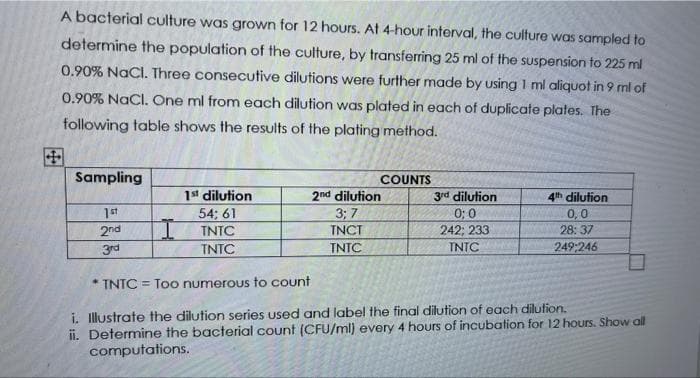A bacterial culture was grown for 12 hours. At 4-hour interval, the culture was sampled to determine the population of the culture, by transferring 25 ml of the suspension to 225 ml 0.90% NaCl. Three consecutive dilutions were further made by using I ml aliquot in 9 ml of 0.90% NaCl. One ml from each dilution was plated in each of duplicate plates. The following table shows the results of the plating method. 田 Sampling COUNTS 1st dilution 54; 61 2nd dilution 3rd dilution 4h dilution 1st 3; 7 0; 0 0,0 2nd TNTC TNCT 242: 233 28: 37 3rd TNTC TNTC INTC 249-246 * TNTC = Too numerous to count i. Illustrate the dilution series used and label the final dilution of each dilution. ii. Determine the bacterial count (CFU/ml) every 4 hours of incubation for 12 hours. Show all computations.
A bacterial culture was grown for 12 hours. At 4-hour interval, the culture was sampled to determine the population of the culture, by transferring 25 ml of the suspension to 225 ml 0.90% NaCl. Three consecutive dilutions were further made by using I ml aliquot in 9 ml of 0.90% NaCl. One ml from each dilution was plated in each of duplicate plates. The following table shows the results of the plating method. 田 Sampling COUNTS 1st dilution 54; 61 2nd dilution 3rd dilution 4h dilution 1st 3; 7 0; 0 0,0 2nd TNTC TNCT 242: 233 28: 37 3rd TNTC TNTC INTC 249-246 * TNTC = Too numerous to count i. Illustrate the dilution series used and label the final dilution of each dilution. ii. Determine the bacterial count (CFU/ml) every 4 hours of incubation for 12 hours. Show all computations.
Basic Clinical Laboratory Techniques 6E
6th Edition
ISBN:9781133893943
Author:ESTRIDGE
Publisher:ESTRIDGE
Chapter7: Basic Clinical Microbiology
Section7.4: The Gram Stain
Problem 5RQ
Related questions
Question

Transcribed Image Text:A bacterial culture was grown for 12 hours. At 4-hour interval, the culture was sampled to
determine the population of the culture, by transferring 25 ml of the suspension to 225 ml
0.90% NaCl. Three consecutive dilutions were further made by using I ml aliquot in 9 ml of
0.90% NaCl. One ml from each dilution was plated in each of duplicate plates. The
following table shows the results of the plating method.
田
Sampling
COUNTS
1st dilution
54; 61
2nd dilution
3rd dilution
4h dilution
1st
3; 7
0; 0
0,0
2nd
TNTC
TNCT
242: 233
28: 37
3rd
TNTC
TNTC
INTC
249-246
* TNTC = Too numerous to count
i. Illustrate the dilution series used and label the final dilution of each dilution.
ii. Determine the bacterial count (CFU/ml) every 4 hours of incubation for 12 hours. Show all
computations.
Expert Solution
This question has been solved!
Explore an expertly crafted, step-by-step solution for a thorough understanding of key concepts.
Step by step
Solved in 4 steps with 1 images

Knowledge Booster
Learn more about
Need a deep-dive on the concept behind this application? Look no further. Learn more about this topic, biology and related others by exploring similar questions and additional content below.Recommended textbooks for you

